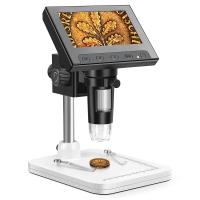How Do Microscopes Help Us ?
Microscopes help us by magnifying objects that are too small to be seen with the naked eye. They allow us to observe and study the intricate details of cells, microorganisms, and other tiny structures. By using different types of microscopes, such as light microscopes or electron microscopes, scientists can explore the world of the microscopic and gain a deeper understanding of various biological, chemical, and physical processes. Microscopes have been instrumental in advancing scientific knowledge and have contributed to numerous discoveries and breakthroughs in fields like medicine, biology, and materials science.
1、 Magnification: Enlarging objects to see small details.
Microscopes play a crucial role in scientific research and various fields of study. They enable us to observe and study objects that are too small to be seen with the naked eye. The primary benefit of microscopes is their ability to magnify objects, allowing us to see small details that would otherwise be invisible.
Magnification is the fundamental function of microscopes. By enlarging objects, microscopes enable scientists to study the intricate structures and processes that occur at the microscopic level. This has been instrumental in advancing our understanding of various scientific disciplines, such as biology, chemistry, and materials science.
In biology, microscopes have revolutionized our understanding of cells, tissues, and organisms. They have allowed us to observe the intricate structures within cells, such as organelles and cellular components, and study their functions. Microscopes have also facilitated the discovery of microorganisms, leading to breakthroughs in the field of microbiology.
In chemistry, microscopes have been instrumental in analyzing the composition and structure of materials at the atomic and molecular level. They have enabled scientists to study the arrangement of atoms in crystals, investigate the properties of nanoparticles, and explore the behavior of molecules.
Moreover, microscopes have found applications beyond the scientific realm. They are widely used in industries such as manufacturing, quality control, and forensics. In manufacturing, microscopes are used to inspect the quality of products, ensuring that they meet the required standards. In forensics, microscopes aid in the analysis of trace evidence, such as fibers, hair, and fingerprints, helping to solve crimes and provide crucial evidence in court.
In recent years, advancements in microscopy techniques have further expanded the capabilities of microscopes. For instance, the development of electron microscopes has allowed scientists to achieve even higher magnification and resolution, enabling the study of nanoscale structures. Additionally, techniques such as fluorescence microscopy and confocal microscopy have enabled the visualization of specific molecules and processes within living cells.
In conclusion, microscopes are invaluable tools that have revolutionized our understanding of the microscopic world. Through magnification, they enable us to observe and study small details that would otherwise be invisible. From advancing our knowledge in various scientific disciplines to aiding in industrial and forensic applications, microscopes continue to play a vital role in expanding our understanding of the world around us.
2、 Resolution: Enhancing clarity and distinguishing fine structures.
Microscopes play a crucial role in scientific research and various fields of study by allowing us to observe and analyze objects that are too small to be seen with the naked eye. They have revolutionized our understanding of the microscopic world and have contributed to numerous scientific discoveries and advancements.
One of the key ways in which microscopes help us is by enhancing resolution, which refers to the ability to distinguish fine structures and details within an object. Microscopes use lenses and advanced imaging techniques to magnify the image of an object, enabling us to see it in much greater detail. This enhanced resolution is particularly important in fields such as biology, medicine, and materials science, where the structure and composition of microscopic objects are of great significance.
For example, in biology, microscopes have allowed scientists to study the intricate details of cells, tissues, and organisms, leading to breakthroughs in understanding cellular processes, disease mechanisms, and the development of new treatments. In materials science, microscopes have enabled researchers to analyze the atomic and molecular structure of materials, leading to the development of new materials with improved properties and applications.
Moreover, the latest advancements in microscopy technology have further expanded our capabilities. Techniques such as confocal microscopy, electron microscopy, and super-resolution microscopy have pushed the boundaries of resolution, allowing us to observe objects at the nanoscale and even visualize individual molecules. These advancements have opened up new avenues of research and have the potential to revolutionize fields such as nanotechnology, drug discovery, and molecular biology.
In conclusion, microscopes are invaluable tools that enhance our ability to observe and understand the microscopic world. By enhancing resolution and distinguishing fine structures, they have contributed to numerous scientific advancements and continue to push the boundaries of our knowledge. The latest advancements in microscopy technology further expand our capabilities and hold great promise for future discoveries.
3、 Illumination: Providing proper lighting for visibility and contrast.
Microscopes play a crucial role in scientific research, medical diagnostics, and various other fields. They enable us to observe and study objects that are too small to be seen with the naked eye, allowing us to delve into the intricate details of the microscopic world. One of the key ways in which microscopes aid us is through illumination.
Illumination is the process of providing proper lighting for visibility and contrast in microscopy. It is essential for enhancing the clarity and resolution of the specimen being observed. Microscopes use various illumination techniques, such as brightfield, darkfield, phase contrast, and fluorescence, to highlight different aspects of the specimen.
Proper illumination helps us to visualize the fine structures, textures, and patterns of microscopic objects. It allows us to distinguish between different components within a specimen, such as cells, tissues, or microorganisms. By adjusting the intensity and angle of illumination, researchers can manipulate the contrast and highlight specific features of interest.
In recent years, advancements in illumination techniques have further revolutionized microscopy. For example, the development of super-resolution microscopy techniques, such as stimulated emission depletion (STED) microscopy and structured illumination microscopy (SIM), has allowed scientists to surpass the traditional diffraction limit of light. This breakthrough has enabled the visualization of even smaller structures and molecules with unprecedented detail.
Furthermore, the integration of digital imaging and computer analysis with microscopes has opened up new possibilities for image processing and analysis. Advanced software algorithms can enhance the visibility of specific structures, remove background noise, and even reconstruct three-dimensional images from multiple two-dimensional slices.
In conclusion, microscopes, through proper illumination, help us by providing the necessary lighting for visibility and contrast. They enable us to explore the microscopic world and gain a deeper understanding of the intricate details of various objects. With ongoing advancements in illumination techniques and digital imaging, microscopes continue to be invaluable tools in scientific research, medical diagnostics, and many other fields.
4、 Observation: Examining specimens and observing their characteristics.
Microscopes play a crucial role in helping us understand the world around us by enabling detailed observation of specimens and their characteristics. Through the use of microscopes, scientists and researchers are able to examine objects and organisms at a microscopic level, revealing intricate details that are not visible to the naked eye.
One of the primary benefits of microscopes is their ability to magnify objects, allowing us to observe and study their structures and functions. By increasing the resolution and magnification power, microscopes enable us to explore the intricate details of cells, tissues, and even individual molecules. This level of observation is essential in various scientific fields, including biology, medicine, chemistry, and materials science.
Microscopes also aid in the discovery and understanding of new species. By examining specimens under a microscope, scientists can identify unique characteristics and classify organisms into different taxonomic groups. This knowledge contributes to our understanding of biodiversity and helps in conservation efforts.
Moreover, microscopes have been instrumental in advancing medical research and diagnostics. They allow scientists and doctors to study disease-causing microorganisms, such as bacteria and viruses, and understand their structures and mechanisms. This knowledge is crucial in developing effective treatments and vaccines.
In recent years, advancements in microscopy techniques have further expanded our understanding of the microscopic world. Techniques like confocal microscopy, electron microscopy, and super-resolution microscopy have revolutionized our ability to observe and analyze specimens with unprecedented detail and precision. These advancements have opened up new avenues of research and have led to breakthroughs in various scientific disciplines.
In conclusion, microscopes are invaluable tools that enable us to observe and study specimens at a microscopic level. They have contributed significantly to our understanding of the natural world, medical research, and technological advancements. As technology continues to evolve, microscopes will undoubtedly play a vital role in furthering our knowledge and pushing the boundaries of scientific exploration.







































